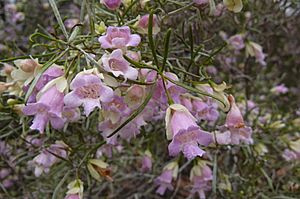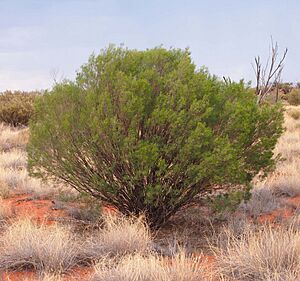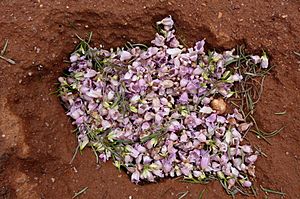Turpentine bush facts for kids
Quick facts for kids Turpentine bush |
|
|---|---|
 |
|
| Eremophila sturtii flowers and leaves | |
| Scientific classification | |
| Genus: |
Eremophila (plant)
|
| Species: |
sturtii
|
| Synonyms | |
The Turpentine Bush, also known as Eremophila sturtii, is a special shrub that grows only in Australia. Aboriginal people have different names for it, like munyunpa and watara. This plant is a medium to large bush with many stems. It has thin leaves and beautiful flowers that are usually lilac or pale purple.
You can find the Turpentine Bush all over the drier parts of Australia. It grows in most mainland states, but it is endangered in Victoria. Sometimes, people see it as a weed because it can spread very easily by growing new plants from its roots.
Contents
What the Turpentine Bush Looks Like
The Turpentine Bush is a shrub that can grow from 1 to 3 meters (about 3 to 10 feet) tall. It has many thin branches. Older plants have dark grey bark with deep cracks.
Its leaves grow one after another along the stem. They are bright green and smell a little bit. Most leaves are about 10 to 50 millimeters (0.4 to 2 inches) long and 0.5 to 2.5 millimeters (0.02 to 0.1 inches) wide. They are long and thin with a curved, hooked end. The leaves are smooth, shiny, and often sticky because of a natural resin.
The flowers usually grow alone, but sometimes in pairs. They are on curved stalks that are 6 to 18 millimeters (0.2 to 0.7 inches) long. Each flower has 5 sepals, which are like small leaves that protect the bud. These sepals are cream-colored to pinkish-purple and sticky. They are usually 7 to 11 millimeters (0.3 to 0.4 inches) long.
The five petals are 12 to 18 millimeters (0.5 to 0.7 inches) long. They join together at the bottom to form a bell-shaped tube. This petal tube is usually lilac, mauve, or pinkish-purple, but sometimes white. It has purple spots. The outside of the petal tube has tiny hairs, and the tips of the petals often have long, thin hairs. The inside of the petal tube is full of long, soft hairs. The four stamens, which are the parts that produce pollen, do not stick out past the end of the petal tube.
The Turpentine Bush flowers from July to October. After flowering, it produces hard, hairy, oval-shaped fruits that are 3.5 to 5 millimeters (0.1 to 0.2 inches) long.
Plant Name and History
The Turpentine Bush was first officially described in 1849 by Robert Brown, a botanist. He published his description in a book about Charles Sturt's travels in Central Australia. The plant was named sturtii to honor Captain Charles Sturt and his explorations.
This plant has many common names, including:
- Turpentine bush
- Narrow-leaved emu bush
- Budda bush
- Small sandalwood
- Scented sandalwood
- Kerosene bush
Different Aboriginal groups also have their own names for the plant:
- Pitjantjatjara people call it munyunpa or watara.
- Anmatyerre people call it atyer or kwenthey.
- Arrernte people call it ilpurt-ilpurte.
Where the Turpentine Bush Grows
The Turpentine Bush is very common in:
- Southwestern Queensland
- Western New South Wales
- Eastern South Australia
There is also a small group of these plants in the far northwest of Victoria. You can also find them in other separate areas, like south-central Northern Territory, eastern Western Australia, and north-central South Australia. It grows well in clay soils on flat plains, red sandy soils, and on low hills made of shale rock.
How it Spreads and Grows
Like its close relative, E. mitchellii, the Turpentine Bush can sometimes be a problem in areas where animals graze. It can grow new plants from its roots, forming large groups of the same plant. If the parts of the plant above ground are removed, it grows back very strongly from its roots. It is also hard to control with fire or special plant sprays (herbicides).
Scientists have studied ways to stop the Turpentine Bush from spreading too much. Early research looked at how it grew back after big fires in 1974. They found that the Turpentine Bush was very good at growing back after a fire, no matter how bad the fire was. Later studies showed that digging the plants out of the soil and covering their roots was the most effective way to control them.
Some people are concerned about removing too many of these woody plants. They are a stable part of the environment. What will replace them if they are removed is still not clear. A native scale insect from the genus Pulvinaria can help control the Turpentine Bush. However, these insects need to be moved by hand to where they are needed.
Protecting the Turpentine Bush
The Government of Western Australia's Department of Parks and Wildlife says this species is "not threatened." In the Northern Territory, it is considered "of least concern." However, it is listed as endangered in Victoria, meaning it is at risk of disappearing there.
Uses of the Turpentine Bush
Traditional Medicine
Aboriginal Australians used the Turpentine Bush, or munyunpa, in many ways for medicine.
- They made a drink or used the ashes to treat backache.
- They used the leaves as a drink or a boiled liquid to treat sores, cuts, head colds, sore eyes, or diarrhoea.
- They also ground the leaves and mixed them with fat to rub on the skin for coughs and colds.
Today, scientists are studying many Eremophila species, including the Turpentine Bush. They are looking for special compounds in these plants that could help fight bacteria that are resistant to antibiotics. This research is difficult and takes a lot of time and money. For the Turpentine Bush, research has focused on creating an antibacterial layer that could be put on medical implants to prevent infections.
Gardening and Plants
Plant groups like the Australian Native Plants Society have worked to grow Eremophila species. The Turpentine Bush is seen as a very good garden plant because it produces so many flowers. People say it "resembles a bridal veil blowing in the wind when in flower."
It is hard to grow this plant from cuttings. Instead, gardeners often join it onto the roots of a Myoporum plant. This helps avoid the problem of the Turpentine Bush spreading too much from its own roots in a garden. It can handle frost and dry weather, making it good for difficult gardens. However, it can cause skin irritation for some people.
Other Uses
The Turpentine Bush has properties that keep insects away. Early European settlers sometimes used its branches to thatch (cover) meat-houses. Aboriginal people used the plant for:
- Making weapons and tools
- Providing shade and shelter
- As a fish poison
- To make fish traps
- They also ate the fruits.



